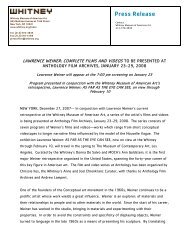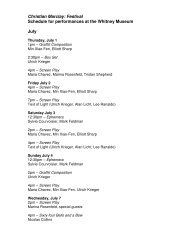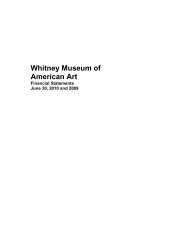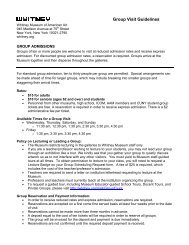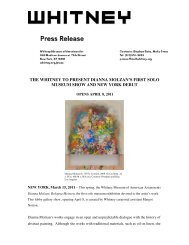Post-visit Materials for Teachers - Whitney Museum of American Art
Post-visit Materials for Teachers - Whitney Museum of American Art
Post-visit Materials for Teachers - Whitney Museum of American Art
Create successful ePaper yourself
Turn your PDF publications into a flip-book with our unique Google optimized e-Paper software.
Images <strong>for</strong> Pre and <strong>Post</strong> Discussions and Activities<br />
2010 <strong>Art</strong>ist In<strong>for</strong>mation<br />
The following artists may be <strong>of</strong> interest to your students (although some are not appropriate<br />
<strong>for</strong> younger audiences). For images and more in<strong>for</strong>mation, please <strong>visit</strong><br />
http://www.whitney.org/Exhibitions/2010Biennial<br />
Nina Berman's photographs document the rarely explored effects and harsh realities <strong>of</strong><br />
contemporary warfare. She engages the viewer with intimate images <strong>of</strong> the consequences <strong>of</strong> war<br />
that is <strong>of</strong>ten given short shrift in the popular media. The 2006 photographs on view in 2010<br />
document the marriage <strong>of</strong> <strong>for</strong>mer Marine sergeant Ty Ziegel, then twenty-four, to his high school<br />
sweetheart, Renee Kline, twenty-one. After being severely disfigured in a suicide bomber’s attack<br />
while stationed in Iraq, Ty underwent fifty reconstructive operations. Berman took spontaneous<br />
photographs <strong>of</strong> Ty and Renee in the weeks leading up to their wedding day and accompanied<br />
them when they had their wedding portrait taken. Berman returned to photograph Ty in 2008 and<br />
describes the later images as suggestive <strong>of</strong> “a com<strong>for</strong>table acceptance with military culture<br />
despite the cost.”<br />
Dawn Clements’s large-scale drawings depict interior domestic spaces, either her own<br />
surroundings or those in classic 1940s and 1950s Hollywood melodramas. She is especially<br />
interested in the idea <strong>of</strong> the home as a place <strong>of</strong> both com<strong>for</strong>t and confinement: “They are places,<br />
no matter how beautiful and wonderful they may appear, that are incarcerating <strong>of</strong> all these<br />
characters. The doors may be unlocked, but somehow the women can’t walk out the door.”<br />
Sculptor, urban planner, and per<strong>for</strong>mance artist Theaster Gates has trans<strong>for</strong>med the <strong>Whitney</strong>’s<br />
Sculpture Court into an installation that functions as a communal gathering space <strong>for</strong><br />
per<strong>for</strong>mances, social engagement, and contemplation. The spare architecture <strong>of</strong> the Main Pavilion<br />
references the artist’s respect <strong>for</strong> Eastern philosophy and art, while the main shoe shine temple<br />
and its activity <strong>of</strong> shoe shining infuses labor with dignity and humility. These architectural<br />
structures also elevate the status <strong>of</strong> simple and found materials. The wood that comprises the<br />
Main Pavilion and surrounding pathways was salvaged from the <strong>for</strong>mer Wrigley gum factory in<br />
inner-city Chicago and cleaned by Gates <strong>for</strong> its conversion into the walls <strong>of</strong> his sacred space.<br />
Throughout 2010, Gates will collaborate with historians, artists, and street musicians on a series<br />
<strong>of</strong> “monastic residencies.” These creative residents will trans<strong>for</strong>m and reinvent the Sculpture<br />
Court by adding what Gates describes as “commentary, bling, and acts <strong>of</strong> sincerity” to the<br />
installation.<br />
Kate Gilmore’s work explores themes <strong>of</strong> displacement, struggle, and female identity. She is the<br />
sole protagonist in her per<strong>for</strong>mative videos, in which she attempts to conquer self-constructed<br />
obstacles. For this work, Gilmore's obstacle is a tall column made <strong>of</strong> sheetrock. She tries to climb<br />
up the column by kicking and punching holes into its walls, and each puncture reveals splashes <strong>of</strong><br />
bright yellow paint from the interior <strong>of</strong> the two layers <strong>of</strong> sheetrock. She works through the<br />
limitations imposed by her feminine clothing—high-heels and a polka-dot dress—with sheer<br />
muscle power and desperate determination. Shot in one take, the outcome <strong>of</strong> her endeavor is<br />
unknown be<strong>for</strong>e the per<strong>for</strong>mance begins. Gilmore's tragicomic displays posit physical situations<br />
as metaphors <strong>for</strong> present-day conflicts and social obstacles.<br />
Thomas Houseago creates figurative sculptures that appear physically imposing and powerful in<br />
their size and positioning yet fragmented and vulnerable in their construction. To construct these<br />
works, Houseago begins with a structure <strong>of</strong> iron rods and then adds a variety <strong>of</strong> traditional<br />
sculptural materials such as plaster, hemp, and wood. Some <strong>of</strong> his works incorporate graphite or<br />
charcoal sketches <strong>of</strong> faces and anatomy on plaster and wood panels. Monstrous yet<br />
© 2010 WHITNEY MUSEUM OF AMERICAN ART<br />
8




